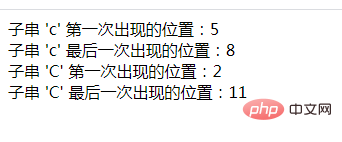 Backend Development
Backend Development
 PHP Tutorial
PHP Tutorial
 PHP string learning detects whether a substring exists (case sensitive)
PHP string learning detects whether a substring exists (case sensitive)
PHP string learning detects whether a substring exists (case sensitive)
In the previous article, we introduced a method to detect whether a substring exists. If you are interested, you can click on the link to view → "PHP string learning to determine whether a substring exists (case insensitive) )》. This time we introduce to you another method to detect whether a substring exists. You can refer to it if you need it.
In the previous article we introduced the use of stripos() and strripos() functions to determine whether a substring exists based on the first or last occurrence of the substring, but these two functions are If it is not case-sensitive, the search will be done without distinguishing between upper and lower case.
Sometimes we need precise positioning and strict detection, so we need to search in a case-sensitive manner. Today we will find out.
Let’s take a look at the following example
<?php
header("Content-type:text/html;charset=utf-8");
$string = "ABCDCBAbcd";
$findme1 = "bC";
$findme2 = "bc";
$pos1 = strpos($string, $findme1);
$pos2 = strrpos($string, $findme1);
$pos3 = strpos($string, $findme2);
$pos4 = strrpos($string, $findme2);
if($pos1 !=FALSE){
echo "子串 '$findme1' 在字符串 '$string' 中存在。";
}else{
echo "子串 '$findme1' 在字符串 '$string' 中不存在。";
}
if($pos2 !=FALSE){
echo "<br>子串 '$findme1' 在字符串 '$string' 中存在。";
}else{
echo "<br>子串 '$findme1' 在字符串 '$string' 中不存在。";
}
if($pos3 !=FALSE){
echo "<br>子串 '$findme2' 在字符串 '$string' 中存在。";
}else{
echo "<br>子串 '$findme2' 在字符串 '$string' 中不存在。";
}
if($pos4 !=FALSE){
echo "<br>子串 '$findme2' 在字符串 '$string' 中存在。";
}else{
echo "<br>子串 '$findme2' 在字符串 '$string' 中不存在。";
}
?>The strpos() and strrpos() functions will search for substrings in the string $string in a case-sensitive manner$findme1 or $findme2. When there is an exact match and a substring exists, the first or last occurrence of the substring in the string will be returned; if the substring is not found in the string, FALSE will be returned.
As can be seen from the above example, only the substring "bc" and the string "ABCDCBAbcd" are completely matched, and the substring "bc" is considered to exist in the string "ABCDCBAbcd". Therefore, the output result is:

Let’s take a closer look at the strpos() and strrpos() functions.
strpos($string,$find,$start)The function can return the position where the substring first appears (case-sensitive);strrpos($string,$find,$start)The function can return the position of the last occurrence of the substring (case-sensitive);
The strpos() and strrpos() functions are similar and both accept two required parameters $string (the string being searched) and $find (the substring to be found) , an omitted parameter $start (the starting position of the search). Note: The string position starts at 0, not 1.
<?php
header("Content-type:text/html;charset=utf-8");
$string = "ABCabcabcABC";
$findme1 = "c";
$findme2 = "C";
echo "子串 '$findme1' 第一次出现的位置:".strpos($string, $findme1);
echo "<br>子串 '$findme1' 最后一次出现的位置:".strrpos($string, $findme1);
echo "<br>子串 '$findme2' 第一次出现的位置:".strpos($string, $findme2);
echo "<br>子串 '$findme2' 最后一次出现的位置:".strrpos($string, $findme2);
?>Output result:

But the parameter of strrpos() function $start can accept negative values when it A negative number will cause the search to end at the count starting at the end of the string.
<?php
header("Content-type:text/html;charset=utf-8");
$string = "ABCabcabcABC";
$findme1 = "c";
$findme2 = "C";
echo "子串 '$findme1' 第一次出现的位置:".strpos($string, $findme1);
echo "<br>子串 '$findme1' 最后一次出现的位置:".strrpos($string, $findme1,-5);
echo "<br>子串 '$findme2' 第一次出现的位置:".strpos($string, $findme2);
echo "<br>子串 '$findme2' 最后一次出现的位置:".strrpos($string, $findme2,-5);
?>Output result:

Okay, that’s all. If you want to know anything else, you can click this. → →php video tutorial
Finally, I recommend reading a classic course "PHP String Processing (Jade Girl Heart Sutra Edition)", it's free~ come and learn !
The above is the detailed content of PHP string learning detects whether a substring exists (case sensitive). For more information, please follow other related articles on the PHP Chinese website!

Hot AI Tools

Undresser.AI Undress
AI-powered app for creating realistic nude photos

AI Clothes Remover
Online AI tool for removing clothes from photos.

Undress AI Tool
Undress images for free

Clothoff.io
AI clothes remover

Video Face Swap
Swap faces in any video effortlessly with our completely free AI face swap tool!

Hot Article

Hot Tools

Notepad++7.3.1
Easy-to-use and free code editor

SublimeText3 Chinese version
Chinese version, very easy to use

Zend Studio 13.0.1
Powerful PHP integrated development environment

Dreamweaver CS6
Visual web development tools

SublimeText3 Mac version
God-level code editing software (SublimeText3)

Hot Topics
 1664
1664
 14
14
 1423
1423
 52
52
 1321
1321
 25
25
 1269
1269
 29
29
 1249
1249
 24
24
 PHP and Python: Comparing Two Popular Programming Languages
Apr 14, 2025 am 12:13 AM
PHP and Python: Comparing Two Popular Programming Languages
Apr 14, 2025 am 12:13 AM
PHP and Python each have their own advantages, and choose according to project requirements. 1.PHP is suitable for web development, especially for rapid development and maintenance of websites. 2. Python is suitable for data science, machine learning and artificial intelligence, with concise syntax and suitable for beginners.
 PHP in Action: Real-World Examples and Applications
Apr 14, 2025 am 12:19 AM
PHP in Action: Real-World Examples and Applications
Apr 14, 2025 am 12:19 AM
PHP is widely used in e-commerce, content management systems and API development. 1) E-commerce: used for shopping cart function and payment processing. 2) Content management system: used for dynamic content generation and user management. 3) API development: used for RESTful API development and API security. Through performance optimization and best practices, the efficiency and maintainability of PHP applications are improved.
 PHP: A Key Language for Web Development
Apr 13, 2025 am 12:08 AM
PHP: A Key Language for Web Development
Apr 13, 2025 am 12:08 AM
PHP is a scripting language widely used on the server side, especially suitable for web development. 1.PHP can embed HTML, process HTTP requests and responses, and supports a variety of databases. 2.PHP is used to generate dynamic web content, process form data, access databases, etc., with strong community support and open source resources. 3. PHP is an interpreted language, and the execution process includes lexical analysis, grammatical analysis, compilation and execution. 4.PHP can be combined with MySQL for advanced applications such as user registration systems. 5. When debugging PHP, you can use functions such as error_reporting() and var_dump(). 6. Optimize PHP code to use caching mechanisms, optimize database queries and use built-in functions. 7
 The Enduring Relevance of PHP: Is It Still Alive?
Apr 14, 2025 am 12:12 AM
The Enduring Relevance of PHP: Is It Still Alive?
Apr 14, 2025 am 12:12 AM
PHP is still dynamic and still occupies an important position in the field of modern programming. 1) PHP's simplicity and powerful community support make it widely used in web development; 2) Its flexibility and stability make it outstanding in handling web forms, database operations and file processing; 3) PHP is constantly evolving and optimizing, suitable for beginners and experienced developers.
 PHP vs. Python: Understanding the Differences
Apr 11, 2025 am 12:15 AM
PHP vs. Python: Understanding the Differences
Apr 11, 2025 am 12:15 AM
PHP and Python each have their own advantages, and the choice should be based on project requirements. 1.PHP is suitable for web development, with simple syntax and high execution efficiency. 2. Python is suitable for data science and machine learning, with concise syntax and rich libraries.
 PHP and Python: Code Examples and Comparison
Apr 15, 2025 am 12:07 AM
PHP and Python: Code Examples and Comparison
Apr 15, 2025 am 12:07 AM
PHP and Python have their own advantages and disadvantages, and the choice depends on project needs and personal preferences. 1.PHP is suitable for rapid development and maintenance of large-scale web applications. 2. Python dominates the field of data science and machine learning.
 PHP vs. Other Languages: A Comparison
Apr 13, 2025 am 12:19 AM
PHP vs. Other Languages: A Comparison
Apr 13, 2025 am 12:19 AM
PHP is suitable for web development, especially in rapid development and processing dynamic content, but is not good at data science and enterprise-level applications. Compared with Python, PHP has more advantages in web development, but is not as good as Python in the field of data science; compared with Java, PHP performs worse in enterprise-level applications, but is more flexible in web development; compared with JavaScript, PHP is more concise in back-end development, but is not as good as JavaScript in front-end development.
 PHP and Python: Different Paradigms Explained
Apr 18, 2025 am 12:26 AM
PHP and Python: Different Paradigms Explained
Apr 18, 2025 am 12:26 AM
PHP is mainly procedural programming, but also supports object-oriented programming (OOP); Python supports a variety of paradigms, including OOP, functional and procedural programming. PHP is suitable for web development, and Python is suitable for a variety of applications such as data analysis and machine learning.



